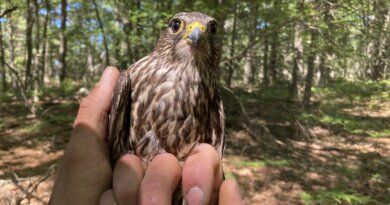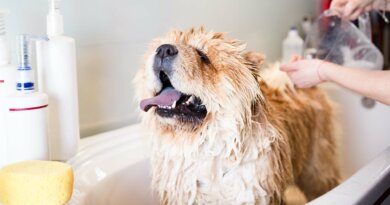Basenji: The Barkless Dog – Is this the Breed for You?
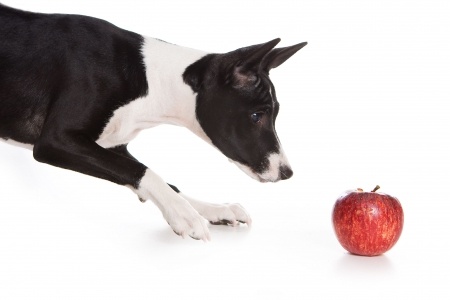
by Janice Jones |Last updated 05-18-2020
Are you in the market for a dog nicknamed the “barkless” dog? If so, the Basenji might be the perfect dog for you. This is one of the very few breeds in the entire world that do not bark.
They have a differently shaped larynx, which causes them not to create a barking sound. Although they are barkless, they are not completely silent. Instead, they make a noise similar to a yodel or a howl, also known as a “barroo.”
They only howl when they are excited or when they are hunting. They were originally bred as a hunting dog in Central Africa and are still used by the pygmies in Central Africa today to hunt lions. Because of this, they are considered very tough dogs.
Unlike some breeds of dogs, they hunt with
their sight and their smell instead of using just one sense. This also makes them extremely intelligent
and very stealthy, as well.
They have a very prominent curled and coiled tail, a wrinkled forehead, and
large, erect ears. These are just a few of the many different features that
make up the Basenji. Another unique characteristic is that they are strangely cat-like.
For example, they like to groom and primp
themselves. If you are looking for a
good family dog that does not bark, then you may want to look into adopting one into your family.
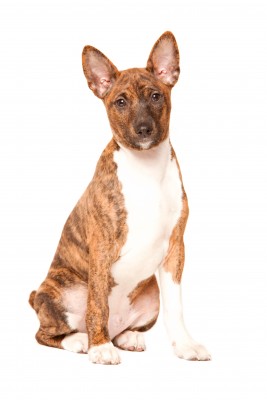
Quick Facts
Other Names Used: African Bush Dog,
African Barkless Dog, Ango Angari, Congo Dog, Zande Dog
Affiliation: Hound Group; AKC
recognized in 1944, CKC, FCI, UKC
Size
Height: Males: 16-17 inches, Females 16-17
inches
Weight: Males: 22-16 pounds, Females 20-15
pounds
Coat Type: Short and fine coat
Colors: Red, Black, Tricolor, Brindle; all
with white chests and stomachs
Country of Origin: Democratic Republic of
the Congo
Activity Level: High energy
Life Expectancy: 10-12 years
Good with
Children: They can work very well with children if raised around them and socialized to small
children as a puppy. An adult Basenji
that is unfamiliar with children may not be too fond of children and could snap
at them. It is essential to teach young
children how to touch and handle this breed and a child should never try to
take away their food or bother a Basenji while it is eating.
Good with Other
Pets: If
raised with other pets, they will be fine with them. The Basenji needs to recognize any other
household pets as family, or there may be problems. Any animal that the dog sees outside running
around is fair game for a Basenji.
History
The
Basenji is arguably the oldest breed of dog, having made an appearance in
Egyptian hieroglyphs and art. They were
brought up the Nile from Central Africa as gifts for the Pharaohs.
In Africa, the breed was used to help guard
and guide in the forests, and warn natives against dangerous animals that might
be approaching. They also were used for
the receiving and pointing of small game and driving the game into nets.
The first litter was born and raised
to maturity in the United States in 1941.
The AKC first recognized the breed in 1944.
Personality
| Traits | Rating |
|---|---|
| Playfulness | |
| Affection Level | |
| Friendliness Towards Strangers | |
| Good with Children | |
| Good with Other Dogs | |
| Good for First Time Owners | |
| Exercise Needed | |
| Ease of Training | |
| Watch Dog Ability | |
| Grooming Requirements | |
| Shedding | |
| Cold Tolerant | |
| Heat Tolerant |
Dog Breed Ratings Got You a Little Confused?
Here’s a little help in understanding them
- Playfulness: Most Playful = 5 Least Playful = 1
- Affection: Most Affectionate = 5 Least Affectionate = 1
- Friendliness Towards Strangers: Most Friendly = 5 Least = 1
- Good With Children: Great= 5 Not Good with Children = 1
- Good With Dogs: Great = 5 Not Good Around Dogs = 1
- Good With First Time Owners: Fine=5 Not Appropriate = 1
- Exercise Required: Extensive Daily Exercise = 5 Minimal = 1
- Ease of Training: Very Easy = 5 Difficult = 1
- Watch Dog: Excellent Watch Dog = 5 Minimal = 1
- Grooming: Time Consuming = 5 Minimal = 1
- Shedding: Heavy Shedder = 5 Minimal = 1
- Cold Tolerance: Well Tolerated = 5 Poor Tolerance = 1
- Heat Tolerance: Well Tolerated = 5 Poor Tolerance = 1
Although
the Basenji doesn’t bark, they can be known to bite. They are curious, alert,
and energetic, but they can be aloof with strangers.
Since they do have a
couple cat-like characteristics, they seem to become attached to one or two members
of the family they belong to, which makes them excellent for individuals, couples or small
families.
These furry friends are very
curious and like to climb, which means that they can somewhat easily climb over
chain link fences, which could pose as a problem depending on the owner’s
location.
They are excellent escape artists, so for this reason, everyone
in the family should be careful about leaving doors or gates open.
They also will spend some time on their hind
legs and lean against walls, furniture, counters, etc. if they are curious
about something that is happening.
Due to their background, they also have a
strong prey drive and could cause problems while walking them because if they
catch sight of a squirrel or stray cat, they will likely try and pursue it.
They are extraordinarily intelligent; however, they are not easy to train. In fact, according to the book, The Intelligence of Dogs: A Guide to the Thoughts, Emotions, and Inner Lives of Our Canine Companionsthe Basenji is the second least trainable breed of dog.
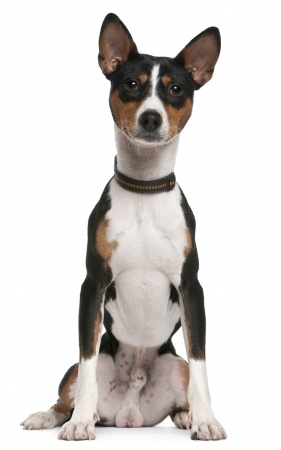 Basenji
BasenjiBecause the breed survived for
thousands of years by being independent
thinkers, they see no need to obey humans. The easiest way to go about
training is with constant positive reinforcement and many treats.
However,
they do not respond well to punishment such as yelling or hitting, and
they
could let off a warning growl if any of those behaviors are
demonstrated. In the end, they will pick and choose who and
what they obey, so keep this in mind during training.
Because of their natural
hunting instinct, they prefer to meet strangers on their own and can tend to be
very independent and aloof. They need to be socialized at a very young age, and
with proper socialization and training, they can be very friendly and welcoming
as an adult.
However, they shouldn’t be
trusted to be alone with small children or other pets. They will get along with
other Basenjis, but do not do as well with cats, small animals, fish, etc.
These guys love to chew, so make sure they have a lot of toys and bones to chew
on, so you don’t end up with a chewed up house or apartment.
Most
of the problems from this breed of dog are between them and their owner. Many
owners think their dog is inactive because they do not bark.
These
dogs are extremely active and require moderate to high amounts of daily
exercise. They need this daily exercise to help release
physical and mental energy and without their physical activity, they can
become
relentless and anxious.
When they play they are very energetic and
tireless and
can run around the yard for hours.
Another problem is that some owners will not
take on the role of a leader, and if so, the pup will acknowledge this. If the owner is not confident and firm, the
Basenji will try very hard to get its own way and harass the owner.
These guys can also become demanding without
a proper pack leader. The ideal owner would be one who
understands basic canine behaviors and treats the dog accordingly. People who
can understand the basic behaviors of them will find the Basenji to be
amazingly wonderful pets.
This breed is probably not a good choice for a first time
dog owner.
Grooming the Basenji
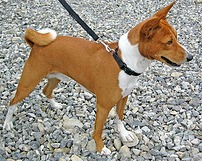 Courtesy Fugzu: Creative Commons
Courtesy Fugzu: Creative CommonsDue
to their thin and short coat, they have very minimal grooming. They don’t shed
often and don’t have that usual “dog” smell, which makes them perfect for
people who don’t want to have to clean up their hair from their couches, rugs,
and the rest of their house. This also makes them ideal for people with
allergies.
Like cats, they like to groom themselves most of the time. Other
than the regular baths, nail clipping, teeth brushing, and regular maintenance,
this breed of dog is very easy to groom and maintain.
Read More About Grooming the Short-Haired Dog.
Health Concerns
In
the 1980s, they were almost wiped out in the United States by Fanconi syndrome,
which is a fatal genetic kidney disease.
This disease was so prevalent in the U.S. that breeders traveled
to the Congo to find and bring back more dogs to help diversify the gene pool.
It is necessary for you to buy your pup from a reputable breeder to try to eliminate the chances of getting a dog
with Fanconi syndrome.
Symptoms include,
but are not limited to excessive drinking, excessive urination, and glucose in
the urine, which is often misdiagnosed as diabetes. If the dog exhibits any of these symptoms, they
should go to the vets as soon as possible as this is considered a medical
emergency.
Other health concerns
include:
Progressive
Retinal Atrophy: A genetic condition common in many breeds that affects the retina of the eye which eventually leads to blindness. Read more.
Hip
Dysplasia: A condition that affects many different dog breeds, where the hip joint is not formed properly, leading to osteoarthritis and lameness. Read more.
Umbilical Hernia: A common condition in many breeds caused either by genetics or injury. It is a rupture where the umbilicus is located resulting in internal organs, intestines or fatty tissue squeeze through. Read more.
Colobom: An inherited eye problem seen in some breeds, where the eye tissue is not completely formed at birth and shows up as a hole or split in the iris of the eye.
Persistent Pupillary Membrane (PPM): This condition has been seen in several breeds of dogs including the Basenji. The blood vessels that supply nutrients to the fetus’ eye remain and can be seen after the puppy is born. Depending on the location of these strands, vision can be affected.
Immunoproliferative Systemic Intestinal Disease: Also known as diarrheal syndrome, it is similar to inflammatory bowel syndrome in people, where the dog is unable to absorb nutrients from his food.
Pros:
- Won’t shed much; suitable
for those with allergies - Don’t bark, although
they can make a lot of noise - Very energetic and
athletic - Don’t carry the usual
doggy odor - Small and love to
cuddle
Cons:
- Difficult to train
- Escape artists
- Aloof with strangers
- Do not like to be
left alone, or without their owners - Howl can be very loud
National Breed Club
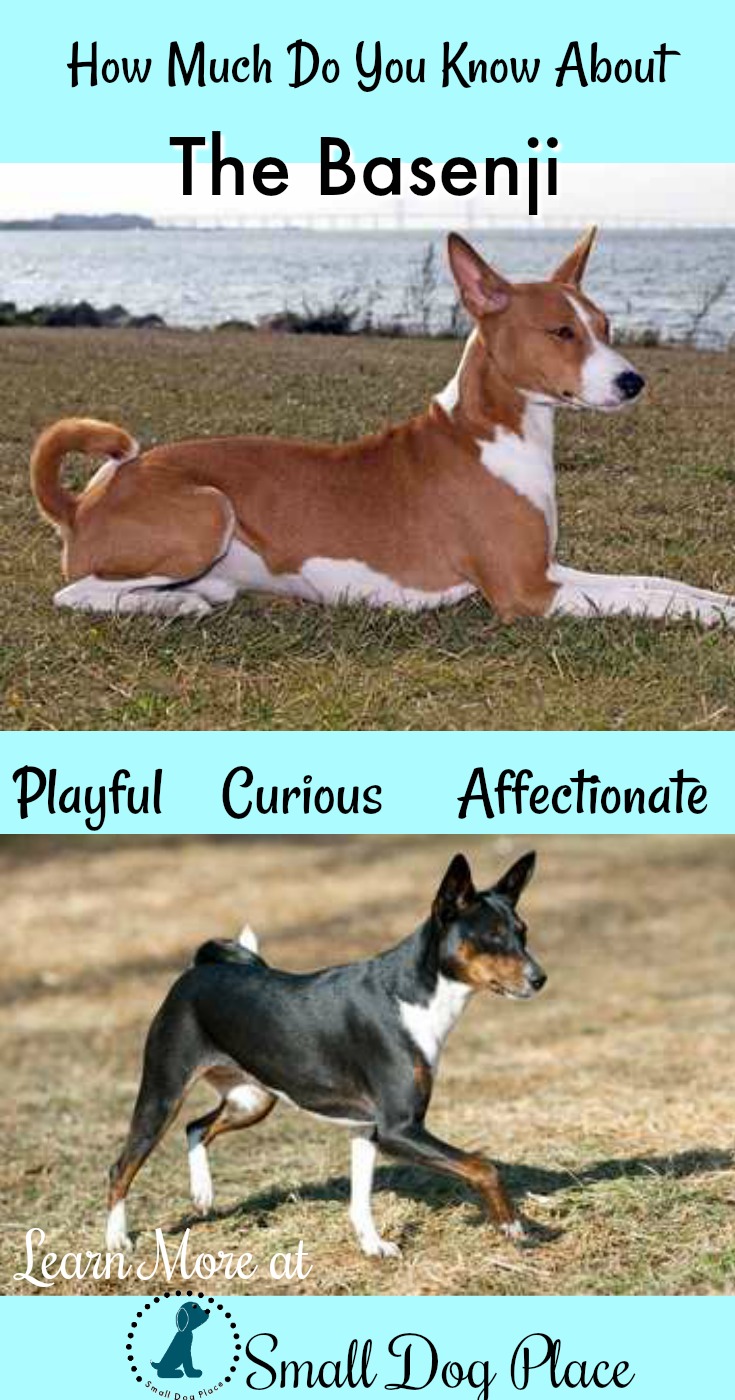
References and Further Reading
Does This Article Deserve Your Thumbs Up?
We always appreciate your support and encouragement. Your thumbs up means so much to us. Please like this article.
If you find this page or any page on Small Dog Place Helpful, or Useful in anyway, I’d love it if you would click the small heart found on the bottom right of each page.
You can also share or bookmark this page — just click on the:

Free Monthly Newsletter
Sign Up for Our Free Newsletter and get our Free Gift to You.
my E-book, The Top 10 Mistakes People Make When Choosing a Dog (and how to avoid them)
If you enjoyed this page, I’d love it if you’d let me know. Just click the button below. Thank you.
Sharing is Caring


